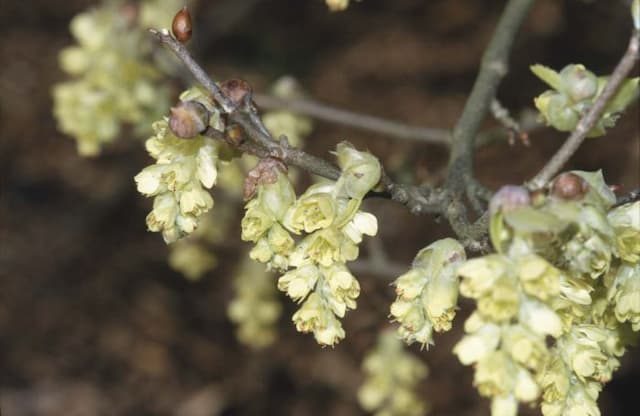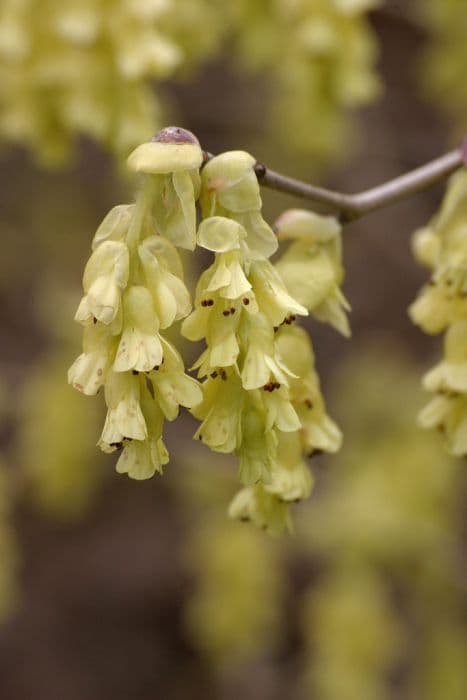Chinese Sycopsis Sycopsis sinensis

ABOUT
Sycopsis sinensis, also known as the Chinese fig, exhibits a lush appearance typical of many woody, broadleaf evergreens. The plant boasts oval-shaped leaves which are dark green on the top with a lighter shade underneath, providing a pleasant contrast. During the blooming season, the Chinese fig produces small, inconspicuous flowers that are later replaced by somewhat more noticeable fruits. The fruit itself is a small, rounded capsule that adds a subtle ornamental value to the plant. The bark on the branches and trunk presents a smooth texture with a grayish-brown hue, contributing to its overall aesthetic. The Chinese fig has a sturdy structure, with branches that extend outward to create a full, dense canopy, which makes it an attractive plant in a landscaped garden or natural setting.
About this plant
 Names
NamesFamily
Hamamelidaceae
Synonyms
Chinese Sycopsis, Chinese Figwort
Common names
Sycopsis sinensis var. calcicola, Sycopsis sinensis var. oblanceolata
 Toxicity
ToxicityTo humans
Sycopsis sinensis, commonly known as the Chinese fig, is not widely reported to have toxic effects on humans. There is limited information available regarding its toxicity, and it does not typically appear on lists of poisonous plants. However, as with any plant, individual allergies or sensitivities could occur. In general, it is always recommended to avoid ingesting parts of ornamental plants due to the potential for unknown toxic compounds. If ingestion occurs and symptoms of poisoning appear, it is advised to seek medical attention. Symptoms could potentially include gastrointestinal upset such as nausea, vomiting, or diarrhea if the plant were to be toxic.
To pets
Chinese fig (Sycopsis sinensis) is not commonly known to be toxic to pets either. There is a lack of specific information about the toxicity of this plant to pets, such as dogs and cats. As there are many plants that can be hazardous to pets, it is always best to prevent pets from ingesting plants that are not confirmed to be safe. If a pet ingests part of this plant and shows signs of illness, including vomiting, diarrhea, or unusual behavior, it is crucial to contact a veterinarian immediately. It's better to err on the side of caution with unknown plants due to the wide range of possible reactions in pets.
 Characteristics
CharacteristicsLife cycle
Perennials
Foliage type
Evergreen
Color of leaves
Green
Flower color
Yellow
Height
10-20 feet (3-6 m)
Spread
10-15 feet (3-4.5 m)
Plant type
Shrub
Hardiness zones
7
Native area
China
Benefits
 General Benefits
General Benefits- Ornamental Value: Sycopsis sinensis, commonly known as Chinese fig, adds aesthetic appeal to gardens and landscapes with its unique foliage and flowers.
- Wildlife Habitat: The plant provides shelter and food for various species of birds and insects, which are drawn to its flowers and fruits.
- Shade Provider: With its broad canopy, the Chinese fig can offer shade in gardens, parks, and urban environments, creating cooler areas during hot seasons.
- Soil Improvement: As a part of its natural growth cycle, the Chinese fig can help in enriching the soil with organic matter through leaf litter decomposition.
- Erosion Control: The root system of this plant helps stabilize soil and can be beneficial in preventing erosion in certain landscapes.
- Windbreak: When planted in rows or as part of a shelterbelt, the Chinese fig can act as a wind barrier, protecting other plants or structures.
- Privacy Screening: Due to its dense foliage, Sycopsis sinensis is often used as a natural screen for privacy in residential and commercial spaces.
 Medical Properties
Medical PropertiesThis plant is not used for medical purposes.
 Air-purifying Qualities
Air-purifying QualitiesThis plant is not specifically known for air purifying qualities.
 Other Uses
Other Uses- The wood of Sycopsis sinensis, known as Chinese fig, is used for fine woodworking and cabinetry due to its attractive grain and texture.
- Chinese fig can be planted as a specimen tree in botanical gardens for educational purposes, showcasing its unique flowering structure and fruit.
- The leaves of the Chinese fig are sometimes used in floral arrangements as filler foliage to add greenery and texture.
- Because of its dense canopy, the Chinese fig is planted in urban environments as a shade tree to reduce heat islands and provide relief from the sun.
- Landscape designers may use Chinese fig for hedges or privacy screens due to its evergreen nature and the ability to tolerate pruning.
- Chinese fig's interesting bark texture can be used as a natural pattern in art projects or as a subject in photography classes aiming to capture natural textures.
- The fruit of Chinese fig can be used to feed some species of birds, helping sustain local bird populations and supporting biodiversity.
- In regions where the Chinese fig is native, the tree is sometimes planted along riverbanks for erosion control due to its extensive root system.
- Woodworkers may use the tree’s smaller branches and twigs for creating intricate decorative items or for wood turnings such as pens or tool handles.
- Chinese fig, with its distinctive look and foliage, is occasionally incorporated into set designs for theater productions to emulate an Asian setting or create a natural backdrop.
Interesting Facts
 Feng Shui
Feng ShuiThe Sycopsis sinensis, commonly known as the Chinese Fig, is not commonly referenced in traditional Feng Shui practice.
 Zodiac Sign Compitability
Zodiac Sign CompitabilityThe Chinese Fig is not used in astrology practice.
 Plant Symbolism
Plant Symbolism- Resilience – Sycopsis sinensis is known for its ability to withstand various environments, symbolizing the resilience and adaptability in facing life's challenges.
- Endurance – This plant often represents the ability to endure over time, as it is a hardy species that can survive unfavourable conditions.
- Growth – With its nature to grow steadily, Sycopsis sinensis embodies the concept of continuous personal growth and development.
- Beauty in Simplicity – The understated elegance of the plant signifies the beauty that can be found in simplicity and subtlety.
 Water
WaterChinese fig will thrive best when watered deeply but infrequently, allowing the soil to dry out slightly between waterings. Aim to water this plant approximately once every 7-10 days, providing around 1-2 gallons of water each time, depending on the size and maturity of the plant and the environmental conditions. During the active growing season in spring and summer, you may need to water more frequently, while in the cooler, dormant winter months, you should reduce watering. Always check the top inch or two of soil for dryness before watering to prevent over-watering, which can lead to root rot.
 Light
LightChinese fig prefers bright, indirect sunlight. The ideal spot for this plant would be in a location where it receives ample light but is shielded from the harsh rays of the direct midday sun, such as near an east or west-facing window that is diffused by sheer curtains or blinds. Avoid placing it in deep shade or overly dark corners, as insufficient light can hinder growth and lead to leggy, weak stems.
 Temperature
TemperatureChinese fig does well in a range of temperatures, ideally between 60 and 75 degrees Fahrenheit. It can tolerate temperatures as low as 50 degrees Fahrenheit and as high as 90 degrees Fahrenheit, but extreme temperatures outside of this range may stress the plant. Avoid placing the Chinese fig in areas with cold drafts or in direct line with heating vents, as dramatic temperature fluctuations can be harmful.
 Pruning
PruningPrune the Chinese fig to maintain shape, remove any dead or damaged branches, and encourage a fuller growth habit. The best time to prune is in late winter or early spring before new growth begins. Pruning can be done once a year or as needed when you notice parts of the plant that require attention. Make clean cuts with sanitized pruning shears to prevent disease spread.
 Cleaning
CleaningAs needed
 Soil
SoilChinese Fig grows best in well-draining soil with a pH of 6.0 to 7.0. A mix of loam, peat, and sand is ideal to facilitate adequate drainage and root aeration. Nutrient-rich soil will help support its growth, but avoid overly wet or compacted soils. Regular application of a balanced, slow-release fertilizer can be beneficial during the growing season.
 Repotting
RepottingChinese Fig should typically be repotted every 2-3 years to prevent root-bound conditions and to replenish its soil. The best time for repotting is in the spring before the onset of the new growing season. Be sure to use a slightly larger pot to accommodate root growth.
 Humidity & Misting
Humidity & MistingChinese Fig prefers moderate to high humidity levels. Aim for a humidity range of 40-60%, which mimics its natural subtropical habitat. This plant does not tolerate dry air well, so using a humidifier or placing a humidity tray beneath the plant can be helpful in maintaining appropriate moisture levels.
 Suitable locations
Suitable locationsIndoor
Ensure bright, indirect light and consistent warmth.
Outdoor
Plant in partial shade, protect from strong winds.
Hardiness zone
7-9 USDA
 Life cycle
Life cycleSycopsis sinensis, commonly known as Chinese Fig, begins its life cycle through seed germination, with seeds typically requiring a period of cold stratification to break dormancy. Upon germination, the seedling will grow and develop into a juvenile plant, establishing its root system and beginning to develop foliage. The juvenile phase transitions to maturity as the plant increases in size and begins to flower, typically after several years of growth. Once mature, Chinese Fig produces inconspicuous flowers that are followed by small, berry-like fruits, which contain seeds for the next generation. These fruits are often dispersed by birds or other wildlife, facilitating the spread of the plant. In its mature stage, the Chinese Fig can continue to reproduce annually, adding new growth and potentially living for many decades under favorable conditions.
 Propogation
PropogationPropogation time
Spring to Summer
Propogation: The Chinese figwort tree, Sycopsis sinensis, can be propagated primarily through seeds. The most popular method involves collecting seeds in the fall shortly after they mature, as freshness improves germination rates. To propagate, one should first stratify the seeds by exposing them to cold temperatures, which can be done by mixing them with moist sand and refrigerating them for about two months. After stratification, the seeds are sown about 1/4 inch deep (approximately 6 millimeters) in a well-draining seed-starting mix. They should be kept moist and at a temperature of around 70 degrees Fahrenheit (21 degrees Celsius), ideally under indirect light conditions. Generally, seedlings emerge within a few weeks, and once sturdy enough, can be transplanted into individual pots or their final outdoor location.









